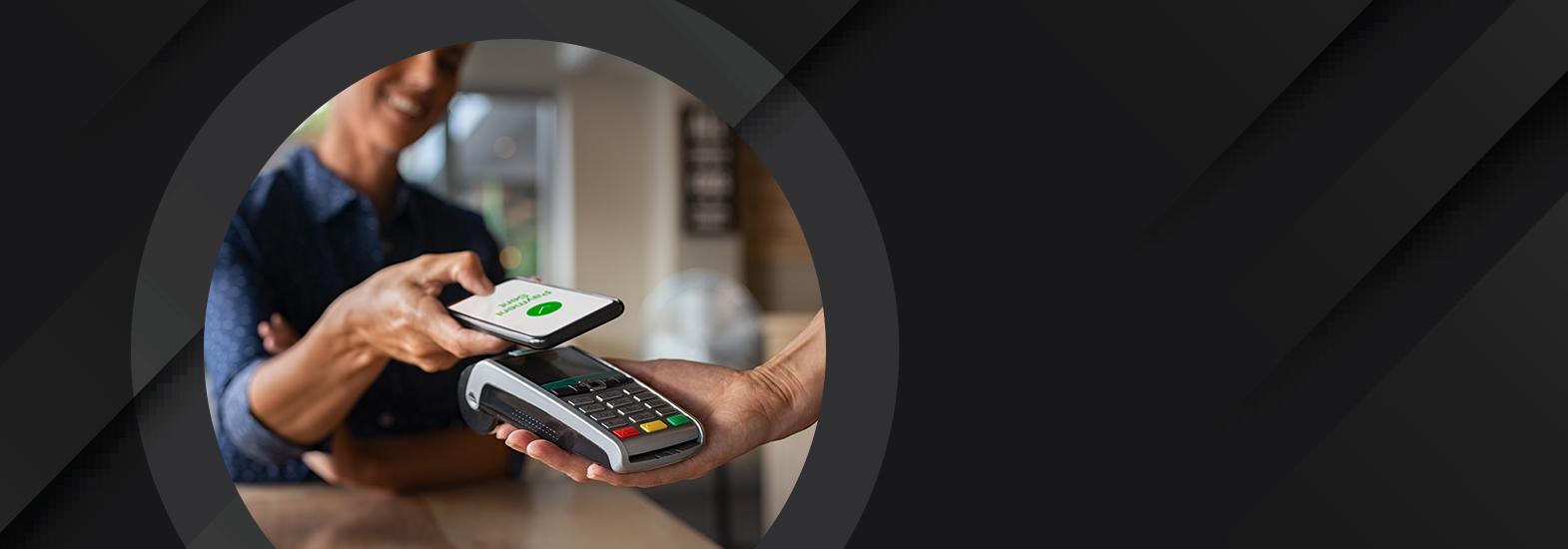5 Min Read • November 8, 2021
Why Demand for In-Store Contactless Payments is Here to Stay

Whether they're tapping to pay with a physical card, using a digital wallet on their smartphone or wearable, or paying with a QR code, the way consumers are paying in person continues to move in one direction: contactless. Are you moving with them?
In the wake of COVID-19, the adoption of contactless payment methods has accelerated globally as consumers prefer low- or no-touch interactions. Digital wallets are becoming the mainstay of in-store payment choices, with contactless cards, kiosk payments and QR codes increasing in popularity for a safer commerce experience.
In fact, 63% of consumers indicated they would switch to a business offering contactless payment options, according to Visa's Back to Business Study. While the main drivers behind 2020's rapid shift were health and safety concerns, contactless payments were already growing in popularity for three simple reasons: speed, convenience, and security.
Contactless Payments are Good for Business
The biggest benefit of going contactless is that it's much quicker than any other in-person payment method. By simply tapping to pay, consumers cut down their wait time at checkout. And, a faster-moving line is an opportunity for businesses to generate more transactions in the same amount of time. On either side of the transaction, a contactless payment is a win-win.
Contactless payments are also more secure. During a contactless payment transaction, the customer's account data is tokenized into a one-time code and passed from a card or mobile device to the contactless reader at the point of sale. Since card details are never revealed, the contactless transaction is safer than a typical swipe-to-pay transaction.
Consumers Want Contactless

Today's digital-native generations have no problem trying out the latest technology innovations. The payment habits of millennials and Gen Z in particular point to the future of contactless. A global study conducted by Mastercard found that over half of millennial and Gen Z consumers are likely to avoid shopping at stores that don't offer contactless payment at point of sale. However, even baby boomers are converts — their preference for contactless increased from 45% before the pandemic to 55% today.
Recognizing this eminent shift in preference across generations, issuers and banks have been rolling out contactless cards for years. In 2018, nearly 60% of credit and debit cards in the UK were contactless, 96% in South Korea, and only about 3.5% in the U.S., according to a report from A.T. Kearney. Consumer demand and competition from digital wallets (like Apple Pay, Alipay and more) have helped to close the gap in contactless card availability across regions.
Contactless Payments Around the World
While it's important for both issuers and merchants to adapt to the growing global popularity of contactless payments, the level of contactless adoption and usage differs between regions and across country borders.
ASIA PACIFIC
When it comes to contactless payments in Asia Pacific, a 2020 Mastercard study found that 91% of consumers were using tap-to-pay, with 75% of them intending to stick with that payment method after the pandemic. The same study also found that the use of QR codes is gaining traction within the region, with 71% of consumers perceiving them as more convenient for in-person payments — thanks to the ubiquitousness of mobile devices.
However, digital wallets are the most common type of online payment method throughout Asia Pacific, with a 46% market share. China has been leading the way in adoption and usage, with 56% of online payments made through digital wallets like Alipay and WeChat Pay.1
NORTH AMERICA
In North America, credit and debit cards are still by far the most used payment method, with 59% of consumers opting for them online. Comparatively, digital wallets are a distant second at 23% market share.2
For Canadian consumers, 56% regularly tap their physical card to make payments, according to Payments Canada. In the U.S., 51% of consumers are now using contactless payments, typically through a contactless card or digital wallet.
EUROPE AND THE UK
Individual European countries vary widely in their preferred payment methods, but digital wallets are popular as an online option, with 21% market share in Western Europe and 25% market share in the UK.3
In the UK specifically, contactless payments accounted for 88.6% of total card transactions in 2020. And while contactless cards have been in use since 2007, the raising of the contactless limit from £30 to £45 in April 2020 — and planned increase to £100 in late 2021 — likely contributed to increased usage.
Thanks to COVID-19, the adoption of contactless payments accelerated rapidly, compressing the pace of change from an expected three- to five-year growth trend into less than a year. While safety might be the top priority when consumers choose tap-to-pay now, the speed and security of contactless payment will ensure it remains a dominant payment method into the future.
CDK Global provides dealers with contactless payments through its CDK OnePay solution, a dealership-wide payment solution fueled by Global Payments Integrated, a leading worldwide provider of payment technology and software solutions. It’s designed to help dealers create a frictionless customer experience with end-to-end seamless payment technologies and expanded payment options. CDK OnePay is offered to dealers with no upfront or recurring subscription fees from CDK.
Some information stated above was originally published on the Global Payments Integrated blog.
- PPRO, Payments Report – Asia-Pacific 2020 - Commissioned by PPRO: Edgar, Dunn & Company.
- PPRO, Payments Report - The North America Report 2020 - Commissioned by PPRO: Edgar, Dunn & Company.
- PPRO, Western and Central Europe Report 2020 - Commissioned by PPRO: Edgar, Dunn & Company
Share This









